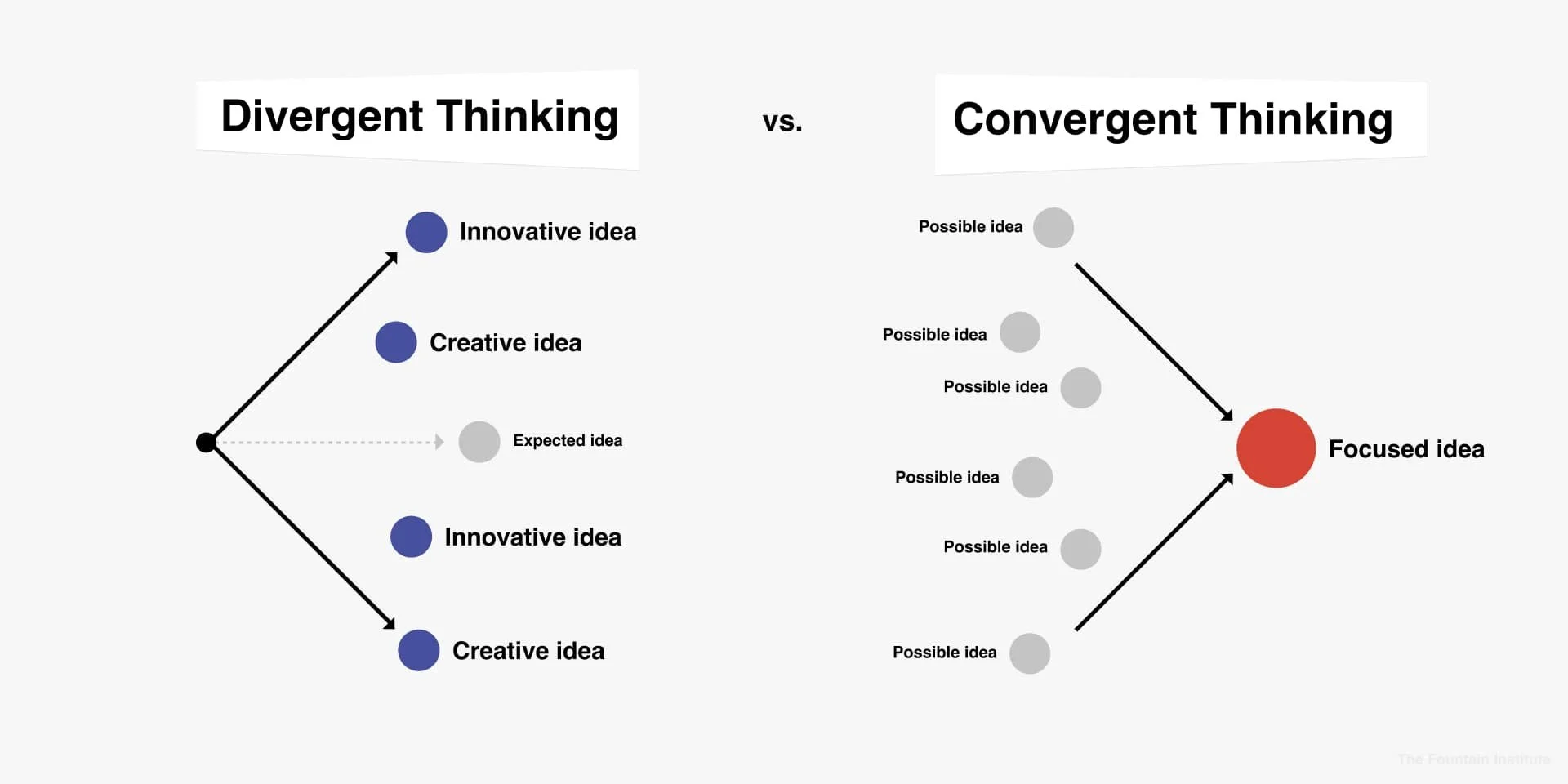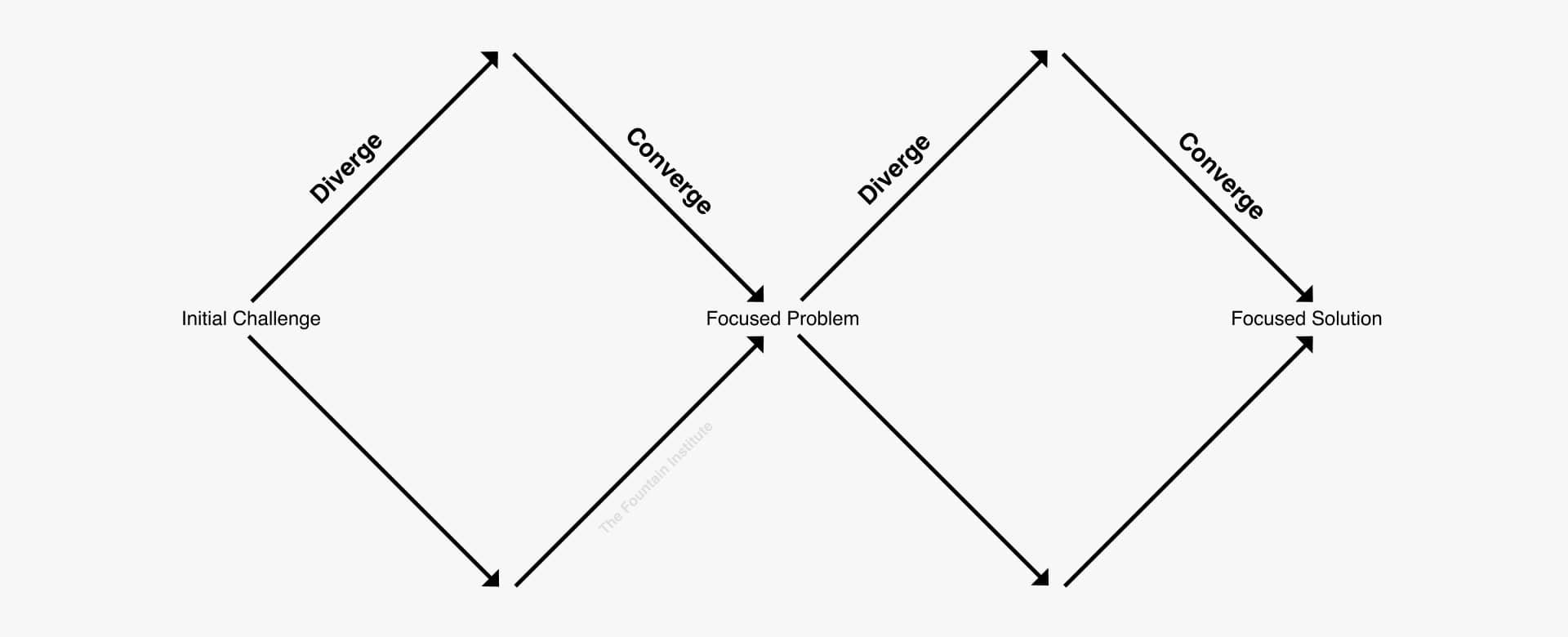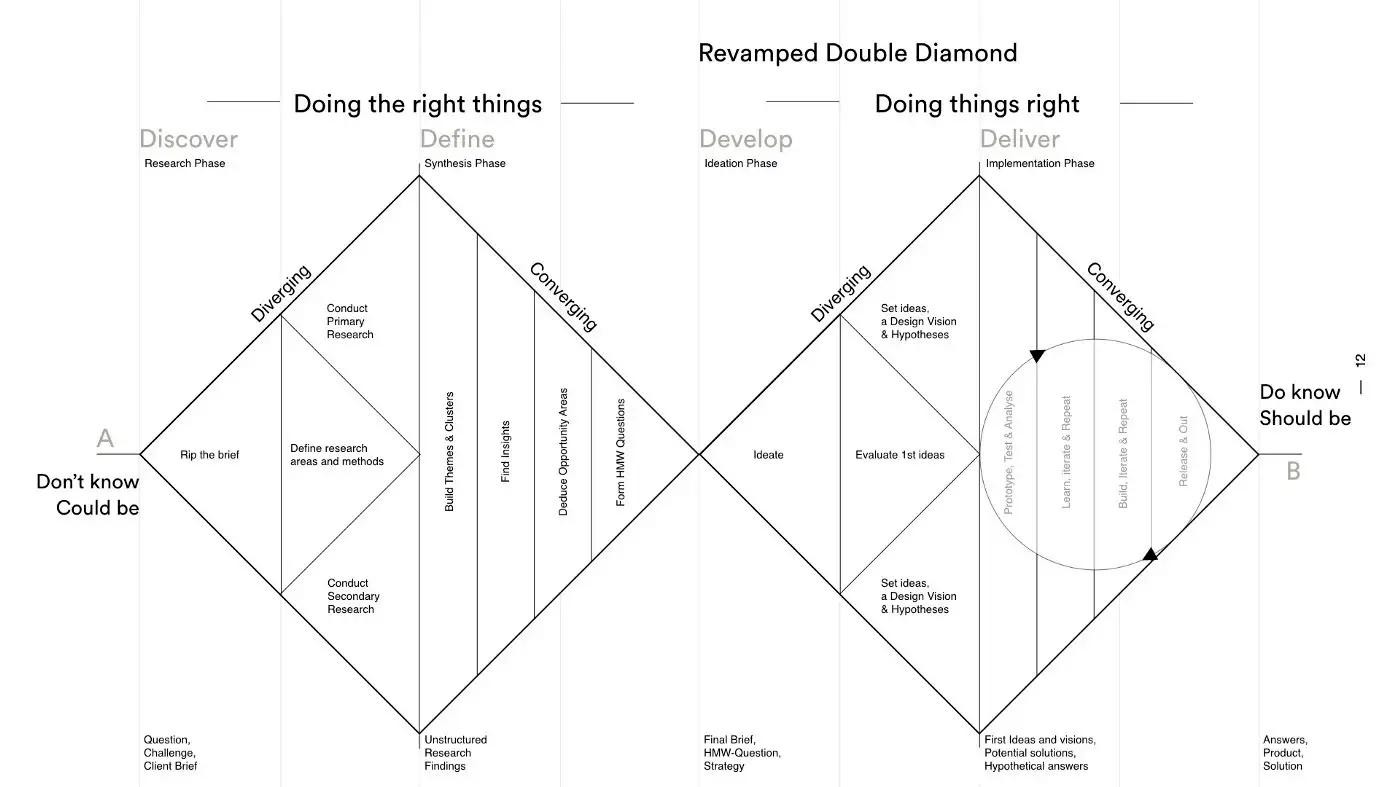What is the Double Diamond Design Process?
A guide for people that want to make sense of design
Reading time: 24 minutes
Jump to a section:
What is the Double Diamond Design Process Model? ⇣
Divergent & Convergent Thinking ⇣
History of the Double Diamond in Problem Solving & Systems Design ⇣
The Double Diamond in Service Design, UX Design, and Product ⇣
What is the Problem Space? ⇣
What is the Solution Space ⇣
The 4 D’s of the Double Diamond ⇣
The Double Diamond & Design Thinking ⇣
Design as a Model, Not a Recipe ⇣
Final Summary ⇣
Learning Resources on the Double Diamond ⇣
The Evolved Double Diamond ⇣
Read this if:
You’re a designer that wants to communicate design to non-designers
You’re a business/product person that wants to understand design
You want to think like a designer…especially a UX, product, or service designer
What is the Double Diamond Design Process Model?
First off, what is the Double Diamond?
The Double Diamond is a visual model to understand the process of design. Its near-universal appeal arises from its simple focus on both the problem and solution.
This process model is an excellent tool for making sense of design. It’s also quite useful for communicating some of the thinking behind newer types of design UX design, product design, and service design. These new fields share something in common: they work on problems and solutions.
A word of warning: the Double Diamond is one of those things that you can't unlearn. Once you understand how it works, you will start seeing problems and solutions everywhere.
Designers can work on Problems and Solutions
The big idea in The Double Diamond is that the problem is just as important as the solution.
Designers are commonly known as problem solvers. Designers won’t argue that point because we do solve problems. We do more than that, however, and the Double Diamond shows two distinct activities in design: problem-finding and problem-solving.
It’s a huge paradigm shift for designers to become problem-finders or researchers. Designers have been working as problem-finders through the 20th century, and the Double Diamond is a simple visual that represents design in the 21st century.
The great thing about the Double Diamond is that even if you've never heard of it, you're probably already using it. This process model has endured the test of time because it’s simple and it communicates how the design process feels.
Divergent & Convergent Thinking
Design requires a different kind of thinking than other activities. The Double Diamond describes the mental approach of design using the duality of divergent and convergent thinking.
Divergent thinking is free-flowing, non-linear, and feels “creative” to some. It helps you explore multiple angles and perspectives while you work. Divergent thinking is one of the reasons that I enjoy being a designer, but it also comes with drawbacks. Divergent thinking can make you lose focus or get lost in the details.
Convergent thinking is focused and linear and can feel like narrowing down to the “right” answer. It helps you scope down projects to the conquerable and deliverable, and it’s essential to balance divergent thinking. Thinking too convergently isn’t good either because it means you miss out on opportunities to explore.
Knowing when to diverge and when to converge in a project is an art. The transition between divergent and convergent mindsets is called the "groan zone," a term from Sam Kaner and his Diamond Participation Model (the diamond process model applied to facilitation). In the groan zone, abandoning ideas is challenging, but moving the project forward is necessary.
If you're working closely with stakeholders, facilitation skills will be vital in transitioning a project from divergence to convergence. Timeboxing and voting are good tactics you can use to push the work past the "groan zone.
These two ways of thinking form the diamond shapes. The diamond shapes in the Double Diamond are the real genius behind this model.
History of the Double Diamond in Problem Solving & Systems Design
The history of the Double Diamond is a story of remixing a nearly fundamental human process, so tracing authorship is difficult. Part of the appeal of the Double Diamond is its universality, and while designers have claimed it, its roots are in advertising and systems design.
The Introduction of the Diamond Process Model
If anyone could be credited with the first draft of the Double Diamond, it’s Alex F. Osborn. Osborn invented the term “brainstorming” and was one of three founders of BBDO, a hugely successful advertising agency that is still successful. But Osborne’s real passion was understanding the creative processes being pioneered at his company.
“Creativity is more than mere imagination. It is imagination inseparably coupled with both intent and effort.”
Osborne’s work in the 1940s to decode and understand the creative process at his agency led him to write several books on the topic, including a 1952 book called Applied Imagination: Principles and Procedures for Creative Problem-Solving. In this book, Osborn unveiled his understanding of the creative process as a diamond that goes from top to bottom.
Osborn teamed up with Sidney Parnes to establish the Osborn-Parnes Creative Problem Solving Process (known as CPS) and created version 2.0 of his original diamond. After Osborn died in 1966, Parnes continued to evolve this visual model of the creative process (learn more about their collaboration here).
[learn more about Osborn and Parnes’ collaboration here]
The Evolution of the Double Diamond
The Double Diamond’s next evolution comes from the divergence-convergence models proposed by Béla H. Bánáthy, a Hungarian linguist and systems scientist. Bánáthy used his1996 Double Diamond (pictured below) to communicate systems design.
Design has a rich history that is related to systems thinking. Many of the prominent industrial designers of the 20th century, like Buckminster Fuller and Victor Papanek, also lectured extensively about systems. It’s no surprise that systems sciences ended up influencing design.
Nigel Cross did a lot of work to apply the thinking of Alex Osborn, Sid Parnes, and Béla H. Bánáthy to the design contexts where the Double Diamond is known today. Cross was a design educator and researcher that helped us understand the thinking that goes into design. He explored the divergent and convergent nature of designerly doing and thinking.
As this new way of thinking about design began to take hold in Europe, The UK Design Council took these “kite-shaped” divergence-convergence models and applied them to the design environment of the early 2000s. Today, the mindsets of divergence and convergence help designers communicate how they think and work in the design process.
[Not pictured: thousands of unnamed frontier practioners that helped evolve design in the 20th century. The evolution of this model visualizes design’s changing role in society, and it is not the work of one person or institution.]
The Double Diamond in Service Design, UX Design, and Product
The rise of Service Design in the early 2000s brought with it the Double Diamond. It’s hard to find a definition of Service Design that doesn’t mention the two diamonds.
UX Design had a meteoric rise around the same time, and UX Designers claim the Double Diamond as their de-facto process. It’s common to see the Double Diamond appear when UX or Product Designers talk about their process.
More recently, Product Managers have adopted the Double Diamond as a product discovery process to communicate the desire to prioritize problems, not just solutions. Problem-finding work and research are crucial parts of Product Discovery. Like the designers that use the Double Diamond, problem-finding and research are easier to communicate when you look at solutions through the lens of the Double Diamond
Anyone who tackles problems and solutions can benefit from the Double Diamond Process Model. You don’t have to be a UX/UI Designer to see value in understanding problems before creating solutions.
What is the Problem Space?
The first diamond is known as the Problem Space. Often labeled the “Research” diamond, the first diamond is where you explore, synthesize, and define problems. The Problem Space introduced the idea that designers can be researchers or problem-finders.
Solve the right problem.
Before designers develop a solution, they must understand the problem they are trying to solve. How do you think designers come up with such innovative solutions? Creative ideas are not the result of an innate gift; they result from a systematic understanding of the world.
The Double Diamond communicates that work in the Problem Space is a natural part of creating. Since design began in the early 1900s, designers have been working in the Problem Space, but the Double Diamond really brought this way of working into the spotlight for non-designers.
The Problem Diamond is so complicated that there are even whole design careers dedicated to it, like UX Research and Strategic Design.
What is the Solution Space?
The second diamond is commonly referred to as the Solution Space. Often labeled the “Implementation Diamond” or just “Design,” the second diamond is where you realize, operate, validate, and scale. These external activities bring ideas to the light of day, like visualizing, iterating, experimenting, and executing solutions.
Before the Double Diamond became famous in 2005, many people thought of design as only one diamond. Even today, the average person on the street will probably think of design exclusively in the Solution Space. The Double Diamond came of age during the rise of service design and helped communicate the idea that designers can be researchers.
Solve the problem right.
Solving a problem right takes a careful understanding of the person interacting with the design because the “rightness” of a design is a very subjective thing. The Solution Space gives designers the much-needed time to check if the design ideas they've visualized will work with their particular audience.
The Solution Diamond is so tricky that there are whole careers dedicated to it, like UI Design and Visual Design.
The 4 D’s of the Double Diamond
activities in the problem and solution are so different that the Double Diamond is broken into four distinct phases. As you move from left to right, each phase has a theme to guide your work.
The Discover Phase Definition
In the Discover Phase, your goal is to immerse yourself in the problem completely through research. In this phase, you should seek to understand, rather than assume, the context of the problem. Discover is the phase where you will conduct exploratory research into the problem or challenge presented. Anything from a field visit to past research can help you explore your problem.
Key Activities
Planning with stakeholders and finding the context
Conducting primary research with customers and relevant experts
Utilizing existing research through secondary or desk research
The Define Phase Definition
In the Define Phase, your goal is to turn your research data into a conquerable problem. In this phase, use your research to define the challenge into a final problem statement. This final problem statement will have more context than the original problem, which will be helpful for the solution work in the next diamond. The process to connect research data with design ideas is called Design Synthesis, and it’s a key part of this phase. This phase is all about putting some organization to the mess of empirical data and forming a concise problem statement.
Key Activities
Identifying customer wants vs. needs
Analyzing and synthesizing research data and forming insights
Scoping the problems down to a final problem statement
The Develop Phase Definition
In the Develop phase, your goal is to generate potential solutions for your defined problem. Just as you went broad with your research, go comprehensive with possibilities of solutions. Develop is the phase where you will generate ideas informed by the first diamond. Seek inspiration from multiple sources and share the creativity with as many stakeholders as possible.
Key Activities
Sketching, wireframing, and prototyping solutions in low fidelity
Collaborating and co-creating with stakeholders
Forming hypotheses and designing experiments
The Deliver Phase Definition
In the Deliver Phase, your goal is to validate the solutions that work and prepare the design for release into the real world. At the beginning of this phase, you will start to weed out the solutions that don't work with early prototyping and testing. As you begin to hone in on what is working, you will iterate and prepare the design for its launch in the real world. This final implementation phase ends with the design work completed.
Key Activities
Testing prototypes or solutions with customers to get early validation
Iterating and preparing assets for launch
Launching pilots, features, and experiments to learn about the customer
The Double Diamond & Design Thinking
Many newbie designers think the Double Diamond and Design Thinking are the same process model. While there are some similarities between the Double Diamond and Design Thinking, they share different purposes.
Design Thinking as a process was standardized in the 1990s by multiple practitioners in the environment of Stanford Design School. Former professors of Standford created IDEO, a design consultancy/marketing agency that sold design as a consulting package.
To this day, Design Thinking remains a way to teach design practices to non-designers, and IDEO still essentially controls the term through their marketing efforts. In 2015, IDEO began selling Design Thinking back to new designers and has sadly been very successful in rebranding design education as Design Thinking education.
While the Double Diamond was also popularized by a design consultancy (the UK Design Council), it isn’t associated with the organization today. Both developed through grassroots efforts, but Design Thinking is a commercially-controlled model, while the Double Diamond remains a grassroots model.
The Design Thinking process from IDEO represents design in five oversimplified steps because its original intention was to train non-designers on the design process in short workshops. While design education is essential, one should be careful about oversimplifying design into a listicle.
Design as a Model, Not a Recipe
The Double Diamond is a helpful model for understanding and communicating design because it isn’t over-prescriptive…it’s merely a thinking model. Its power lies in its ability to map the complexity of design.
Problems arise when you attempt to follow the model like a recipe. Instead of a recipe, use the Double Diamond as a map to orient your practice and communicate design to non-designers.
If design were a step-by-step recipe, it would already be automated.
Models are helpful sensemaking tools, but you might miss the point if you treat them like recipes. Design requires working with various changing inputs, outputs, and parameters. Modeling design is better than simplifying it to a list of prescriptive steps.
Final Summary
The diamonds in the Double Diamond come from divergent & convergent thinking
The problem and solution diamond work in tandem to create better outcomes
The Diamond Diamond evolved in the 20th century and models the practice of Service Design, UX Design, and Product Design in the 21st century
The Four D’s of the Double Diamond are Discover, Define, Develop, and Deliver
The Double Diamond and Design Thinking are two distinct processes with different histories and different purposes
A design process model isn’t a recipe; it’s a communication tool
There are many design process models to choose from, but the Double Diamond remains an excellent tool for understanding and communicating the design domain in the 21st century. After more than a decade in design, I still find this helpful model for my work, and I hope you will too.
Learning Resources on the Double Diamond
Read the book, Applied Imagination: Principles and Procedures for Creative Problem-Solving by Alex Osborn
Read the book, Designing Social Systems in a Changing World by Béla H. Bánáthy
Learn more about the history of the Double Diamond in Choreographing Creative Thinking by Cliff Guren
Read about the Double Diamond framework from the UK Design Council
Read how the Double Diamond is used to build products in What is Product Discovery? by Jeff Humble
Read a visual presentation about the Reality of the Double Diamond by the Fountain Institute
Watch a walkthrough of the Double Diamond UX Design Process by femke.design on Youtube
Watch Divergent vs Convergent Thinking with UX Double Diamond by vaexperience on Youtube
Check out our Free Resources page for design tools and frameworks for advanced design work
Courses on the Double Diamond
For advanced, hands-on training in the Problem Space, take this 22-day course by the Fountain Institute
For advanced, hands-on training in the Solution Space, take this 22-day course by the Fountain Institute
The Evolved Double Diamond
The Double Diamond is a framework that can spark creativity in many contexts. Practitioners use and adapt the model to their purposes, creating new evolutions.
Here are a few notable evolutions of the Double Diamond.
Revamped Double Diamond
Read How to apply a design thinking, HCD, UX or any creative process from scratch by Dan Nessler
Systemic Design Framework
Read how the Design Council revamped the Double Diamond with a non-linear approach in Developing our new Systemic Design Framework by Cat Drew
The Double Diamond of Speculative Design
Read about the Double Diamond of Speculative Design by Cristina Colosi
The A.I.-Augmented Double Diamond
Read an academic paper on Innovation using an A.I.-Augmented Double Diamond by Sebastian G. Bouschery, Vera Blazevic, and Frank T. Piller


















